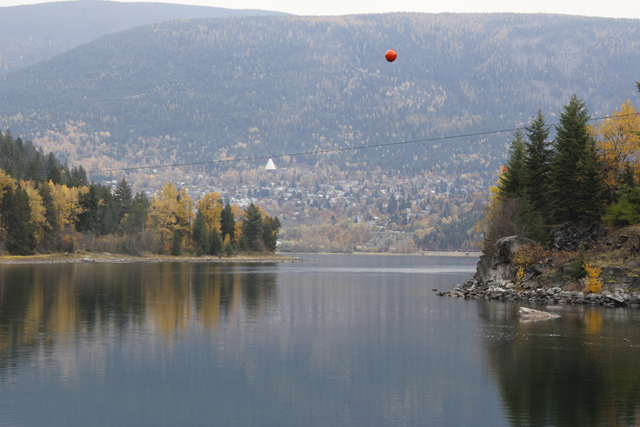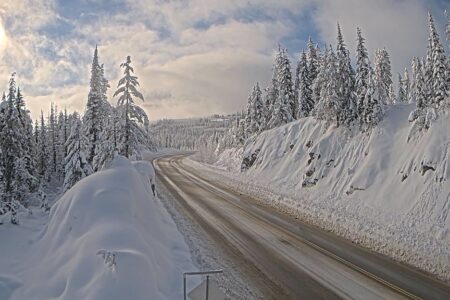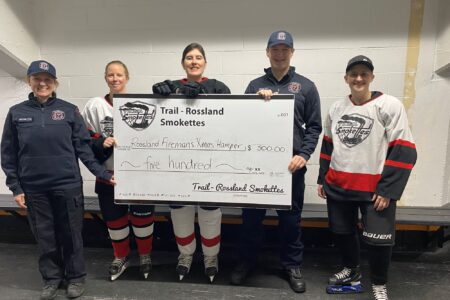The scope narrows on Grohman Narrows project in wake of open house
The flood gates were opened for public comment on the proposed Grohman Narrows dredging project as Nelsonites received an inside look at the multi-million dollar project on Oct. 29.
Nearly 150 people attended the open house on the findings from a study phase of the project, and the majority of those people were spoken to individually by BC Hydro representatives in an attempt to assemble an understanding of the public’s sentiment on the proposed project, said BC Hydro representative Mary Anne Coules.
The public’s questions were primarily about operational modelling and environmental considerations.
The feedback was deemed “valuable,” said Coules, but not conclusive.
Although the feedback will be considered in determining the next steps for the project, a decision has not yet been made on whether or not to proceed to the next phase of the project, Coules noted.
“A decision will likely be made in early 2016,” she said.
Grohman Narrows is a natural constriction on the Kootenay River, located approximately three kilometres downstream of Nelson. During periods of high inflow into Kootenay Lake, this constriction can contribute to unavoidably high lake levels and flooding.
That flooding became problematic in 2012 when the lake rose to a level not seen in 38 years. As a result of that high‐water event and the consequent flood damage to properties around Kootenay Lake and downstream, regional leaders encouraged BC Hydro to fully investigate improvements to Grohman Narrows.
Those regional leaders met with BC Hydro in a special presentation on Oct. 29 to the Regional District of Central Kootenay board of directors. Area F director Tom Newell said, according to the project, the impact of any kind of deepening of Grohman Narrows only affects the lake level for four months of the year — going from freshet into peak time in early July.
For the rest of the year there’s absolutely no impact on lake levels, said Newell.
“I think based on what phase two of their development plan would be it looks like there’s a lot of potential for it to save flooding during those peak times,” he said.
Newell noted that BC Hydro has looked at “every piece they’ve had,” right from artifacts around the lake to impacts on lakeshore to the communities to Nelson Hydro.
“If they move forward I’d support them moving through to phase two to what the viability of the plan is,” he said.
Newell dismissed the notion the project was simply a power grab by BC Hydro.
“(Hydro’s) engineering documents look pretty good to me,” he said. “Everyone that I’ve spoken to agrees (Grohman Narrows) is where the bottleneck is and in 2012 that’s where the problem was.
“It didn’t matter how much they opened the gates at the dams, the water wasn’t getting past the Grohman Narrows.”
Nelson Mayor Deb Kozak said the project is not a big power generator like some of the other projects BC Hydro has in the works, but it will result in some power generation that will pay for the project in time.
“But it will also benefit Nelson Hydro,” she said. “However, I was pleased that they are approaching this cautiously and are considering all aspects of it, including environmental, fish habitat, archaeological sites.”
All areas of the project have been studied, said Coules, including regulations, environmental impacts, social ramifications, property and potential costs and have revealed no “significant obstacles” to proceeding with a Grohman Narrows channel improvement project.
In early 2013, BC Hydro initiated an engineering study to investigate the feasibility, costs, and benefits of such channel improvements.
Improvements at Grohman Narrows would provide greater flood control, improve the operating flexibility for the Kootenay Lake system and provide power benefits to downstream generating stations in Canada (and potentially in the U.S.).
Geotechnical studies released at a public meeting in Nelson last year revealed bedrock still lying thick across most of the Grohman Narrows area — and bed materials which consist of a mix of sand, gravel and cobbles — but would not influence dredging operations. The only significant sediment comes from Grohman Creek.
If the project moves ahead — with the channel deepened, not widened — the next phase would take up to two years and would be subject to regular re-evaluation of the project impacts, costs and benefits.
The economic benefits and costs for the Grohman Narrows project are very uncertain at this stage of the project, Coules admitted. The low excavation scenario is expected to be economic; the medium scenario is expected to be marginally economic.
The high scenario — which would bring the biggest energy benefit and lower the lake approximately two feet — is not economic and would likely be excluded from further study, Coules noted.
There are a number of major factors affecting the project cost, including excavation methodology, timing and material management options.
However, Coules said preliminary cost estimates range from $21 million to $68 million for the low to high volume scenarios. BC Hydro will pay for the project, said Coules.
Further work needed
If a decision is made to proceed to the next phase of the project, further studies will likely include:
- Engineering: confirm characteristics of sub‐surface river bed materials, additional hydraulic modelling to refine excavation levels, additional operations modelling, erosion studies, modelling to address river bed changes post‐dredging and review of dredging methodologies and material management options.
- Environmental: kokanee spawning surveys, Kootenai white sturgeon, analysis of the effects of flow and water level changes, material management options, and environmental management and mitigation plans.
— Source: BC Hydro Grohman Narrows Update
























